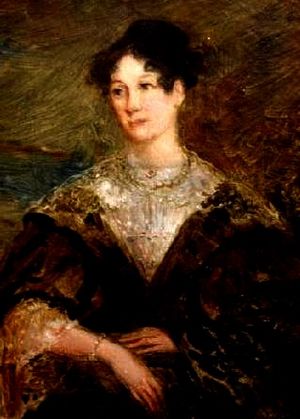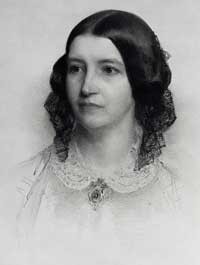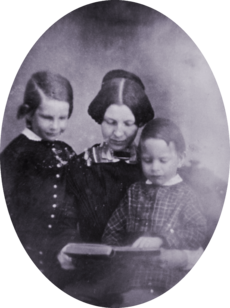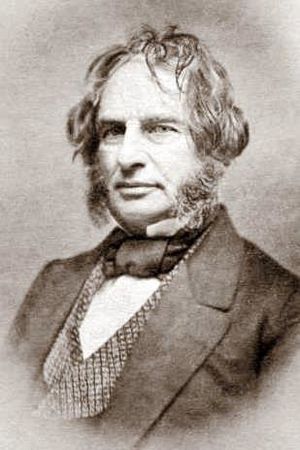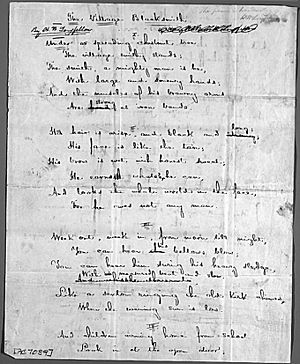Henry Wadsworth Longfellow facts for kids
Quick facts for kids
Henry Wadsworth Longfellow
|
|
|---|---|
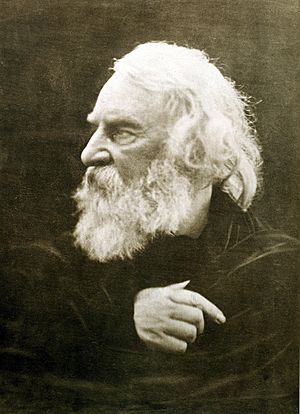
Longfellow photographed by Julia Margaret Cameron in 1868
|
|
| Born | February 27, 1807 Portland, Maine, U.S. |
| Died | March 24, 1882 (aged 75) Cambridge, Massachusetts, U.S. |
| Occupation |
|
| Alma mater | Bowdoin College (AB) |
| Spouses |
|
| Children | 6, including Ernest and Alice |
| Relatives | Alexander Wadsworth Longfellow Jr. (nephew) |
| Signature | |
Henry Wadsworth Longfellow (February 27, 1807 – March 24, 1882) was a famous American poet and teacher. He wrote many well-known poems like "Paul Revere's Ride", The Song of Hiawatha, and Evangeline. He was the first American to fully translate Dante Alighieri's long poem Divine Comedy. Longfellow was also one of the "fireside poets" from New England, whose poems were popular to read aloud by the fire.
Longfellow was born in Portland, Maine, which was part of Massachusetts at the time. He went to Bowdoin College and later became a professor there. After studying in Europe, he taught at Harvard College. His first big poetry books were Voices of the Night (1839) and Ballads and Other Poems (1841). In 1854, he stopped teaching to focus only on his writing. He lived the rest of his life in Cambridge, Massachusetts, in a house that used to be George Washington's headquarters during the American Revolutionary War.
Longfellow faced sadness in his life. His first wife, Mary Potter, passed away in 1835. His second wife, Frances Appleton, died in 1861 after her dress accidentally caught fire. After this tragedy, it was hard for Longfellow to write poetry for a while. He spent time translating books from other languages instead. Longfellow passed away in 1882.
Longfellow wrote many poems that were like songs, known for their musical sound. They often told stories from myths and legends. He became the most popular American poet of his time, and his work was also loved overseas. Some people said he copied European styles or that his poems were too emotional.
Contents
Life and Work of Henry Wadsworth Longfellow
Early Life and Education
Henry Wadsworth Longfellow was born on February 27, 1807. His parents were Stephen and Zilpah Longfellow. He grew up in Portland, Maine, which was then a part of Massachusetts. His childhood home is now known as the Wadsworth-Longfellow House. His father was a lawyer. His grandfather, Peleg Wadsworth, was a general in the American Revolutionary War.
Henry was named after his mother's brother, Henry Wadsworth. This uncle was a Navy lieutenant who had died a few years earlier. Henry was the second of eight children in his family. His family had come from English settlers who moved to New England in the early 1600s.
Longfellow started school at age three. By age six, he was at the private Portland Academy. He was known for being very focused on his studies. He became good at Latin. His mother helped him love reading and learning. She introduced him to books like Robinson Crusoe.
He published his first poem when he was 13. It was called "The Battle of Lovell's Pond." He studied at the Portland Academy until he was 14. He often spent his summers on his grandfather's farm in Hiram, Maine.
In 1822, when he was 15, Longfellow went to Bowdoin College in Brunswick, Maine. His brother Stephen went with him. His grandfather had helped start the college, and his father was on its board. At college, Longfellow met Nathaniel Hawthorne, who became a friend for life. He worked hard on his writing. He published almost 40 poems before he graduated in 1825. He was one of the top students in his class.
Travels in Europe and Teaching Jobs
After graduating in 1825, Longfellow was offered a job. He would teach modern languages at Bowdoin College. He was asked to travel to Europe first to study French, Spanish, and Italian.
Longfellow began his trip to Europe in May 1826. He spent three years traveling. His father paid for the trip, which cost a lot of money. He visited France, Spain, Italy, Germany, and England. He learned French, Italian, Spanish, Portuguese, and German. He mostly taught himself these languages. In Madrid, he met Washington Irving, a famous writer. Irving encouraged Longfellow to keep writing. While in Spain, Longfellow learned that his sister Elizabeth had passed away.
When he returned in 1829, he first turned down the teaching job. He felt the pay was too low. But the college raised his salary. He also became the college's librarian. While teaching, he translated textbooks. His first published book was a translation of poems by a Spanish poet in 1833.
He wrote a travel book called Outre-Mer: A Pilgrimage Beyond the Sea. It came out in parts before being published as a full book in 1835. Longfellow thought about moving to New York for a new teaching job. But he decided to stay at Bowdoin. He sometimes felt unhappy with his teaching work. He wrote that he felt he was "born for a higher lot."
On September 14, 1831, Longfellow married Mary Storer Potter. She was a friend from his childhood in Portland. They lived in Brunswick. In 1833, Longfellow published some stories inspired by Washington Irving.
In 1834, Longfellow received an offer from Harvard College. They wanted him to be a professor of modern languages. He had to spend about a year in Europe first. There, he studied German and other languages. In October 1835, his wife Mary became very ill during the trip. She passed away on November 29, 1835, at age 22. Longfellow was very sad. He wrote that he was "weary and sad" all day. Later, he wrote the poem "Footsteps of Angels" about her.
Longfellow returned to the United States in 1836. He started his job as a professor at Harvard. He rented rooms in the Craigie House in Cambridge. This house was built in 1759. It had been George Washington's headquarters during the Siege of Boston in 1775. The house is now a historic site.
Longfellow started publishing his poetry in 1839. His first poetry book was Voices of the Night. It had some of his original poems and some he wrote as a teenager. In 1841, Ballads and Other Poems was published. This book included popular poems like "The Village Blacksmith" and "The Wreck of the Hesperus". He became popular as a professor.
Meeting Frances Appleton
Longfellow met Frances "Fanny" Appleton and her family in Switzerland. Fanny was the daughter of a wealthy Boston businessman. Longfellow began to try to win her over. Fanny was not sure she wanted to get married. But Longfellow was determined. He wrote to a friend, "The lady says she will not! I say she shall!"
During this time, Longfellow often walked from Cambridge to Fanny's home in Boston. He crossed the Boston Bridge. This bridge was later replaced and renamed the Longfellow Bridge in his honor.
In 1839, Longfellow published Hyperion. This book was inspired by his travels and his efforts to win Fanny. He also published the play The Spanish Student in 1842.
Longfellow also published Poems on Slavery in 1842. This was his first public support for ending slavery. The poems were very gentle. One critic said they were "the thinnest of all Mr. Longfellow's thin books." But the New England Anti-Slavery Association still liked them enough to print more copies.
On May 10, 1843, Fanny Appleton finally agreed to marry him. They were married soon after. Fanny's father bought the Craigie House for them as a wedding gift. Longfellow lived there for the rest of his life. He showed his love for Fanny in his poem "The Evening Star." He wrote, "O my beloved, my sweet Hesperus! My morning and my evening star of love!"
Henry and Fanny had six children: Charles, Ernest, Fanny, Alice, Edith, and Anne. Their daughter Fanny was born in 1847. Longfellow published his long poem Evangeline a few months later. His income from writing grew a lot. In 1840, he made $219 from his work. By 1850, he made $1,900.
In 1854, Longfellow stopped teaching at Harvard. He wanted to spend all his time writing. Harvard gave him an honorary degree in 1859.
Frances's Passing
On July 9, 1861, Frances was putting her children's hair into an envelope. She was trying to seal it with hot wax. Her dress suddenly caught fire. It's not clear exactly how it happened. Longfellow woke up from a nap and rushed to help her. He tried to put out the flames with a rug and his own body. But she was badly burned.
Frances was taken to her room. She passed away the next morning, July 10. Longfellow had also burned himself trying to save her. His face was injured, and he stopped shaving. He wore a beard from then on, which became his famous look.
Longfellow was heartbroken by Frances's death. He never fully got over it. He wrote about his sadness in the poem "The Cross of Snow" (1879). He wrote it 18 years later to remember her:
- Such is the cross I wear upon my breast
- These eighteen years, through all the changing scenes
- And seasons, changeless since the day she died.
Later Life and Death
Longfellow spent several years translating Dante Alighieri's Divine Comedy. To help him, he invited friends to meet every Wednesday starting in 1864. This "Dante Club" included writers like William Dean Howells and James Russell Lowell. The full translation was published in 1867. Longfellow kept working on it. By 1868, Longfellow's yearly income was over $48,000.
In the 1860s, Longfellow supported the end of slavery. He hoped for peace between the northern and southern states after the American Civil War. His son was hurt during the war. Longfellow wrote the poem "Christmas Bells," which later became the carol I Heard the Bells on Christmas Day. He wanted "harmony" between the North and South.
On August 22, 1879, a fan visited Longfellow's house. She didn't know it was him. She asked, "Is this the house where Longfellow was born?" He said no. Then she asked if he had died there. He replied, "Not yet."
In March 1882, Longfellow became very ill with stomach pain. He passed away on Friday, March 24, surrounded by his family. He was buried with both of his wives at Mount Auburn Cemetery in Cambridge, Massachusetts. In his last years, he translated poems by Michelangelo. This work was published after his death. Many scholars believe it showed his feelings as an aging artist facing death.
Longfellow's Writing Style
Poetic Style
Most of Longfellow's work is called lyric poetry. But he tried many different forms. His poems often had a musical sound. He believed that a writer wants the reader to "listen" rather than just "like" their work.
Longfellow was a very private person. He usually did not put details from his own life into his poems. Two exceptions were about the deaths in his family. "Resignation" was written after his daughter Fanny passed away in 1848. It is a general poem about sadness. His poem "The Cross of Snow" was about his second wife Frances's death. It was not published until after his own death.
Longfellow often taught lessons in his poetry. He focused on this less as he got older. Many of his poems shared cultural and moral values. They often suggested that life is more than just about money. He used allegory in his work. For example, in "Nature," death is shown as a child going to bed. He got ideas for his poems from legends and myths. For example, he used Norse mythology for "The Skeleton in Armor" and Finnish legends for The Song of Hiawatha.
Longfellow rarely wrote about current events. He seemed separate from what was happening in America at the time. Still, he wanted American literature to be of high quality.
He was important as a translator. His translation of Dante's Divine Comedy was very important for people who wanted to be well-read. He also helped other translators. In 1845, he published The Poets and Poetry of Europe. This was a huge book of translations by many different writers.
Longfellow's Legacy
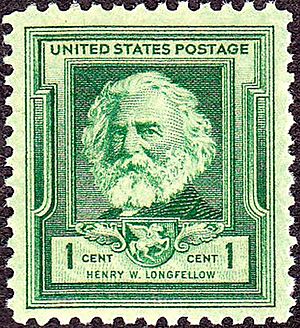
Longfellow was the most popular poet of his time. A friend once said, "no other poet was so fully recognized in his lifetime." Many of his poems helped shape American identity. This was especially true for "Paul Revere's Ride". He was so admired that his 70th birthday in 1877 felt like a national holiday. There were parades, speeches, and readings of his poems.
After his death, Longfellow's popularity went down. Other poets like Walt Whitman became more popular. Some critics in the 20th century said his poems were not very deep. However, some recent writers have defended Longfellow. They say he was unfairly forgotten.
Over the years, Longfellow's gentle personality became part of his fame. His brother Samuel wrote a biography that showed him as sweet and modest. His friend Ralph Waldo Emerson called him "a sweet and beautiful soul." But in reality, his life was harder than people thought. He had constant pain and poor eyesight. He found it very hard to deal with his second wife's death. Longfellow was a quiet and private person. In his later years, he avoided leaving his home.
Longfellow became one of the first American celebrities. He was also popular in Europe. It was said that 10,000 copies of The Courtship of Miles Standish sold in London in one day. Children loved him. The "spreading chestnut-tree" from "The Village Blacksmith" was cut down. The children of Cambridge had it made into an armchair and gave it to him.
In 1884, Longfellow became the first non-British writer to have a statue of him placed in Poet's Corner of Westminster Abbey in London. He is still the only American poet honored there with a statue. A public monument to Longfellow was put up in his birthplace of Portland, Maine, in 1888. In 1909, another statue of him was revealed in Washington, D.C. In March 2007, the United States Postal Service released a stamp honoring him.
To remember their father, Longfellow's children gave land to the City of Cambridge. This land became Longfellow Park. A monument there shows characters from his works.
List of Works
- Outre-Mer: A Pilgrimage Beyond the Sea (Travelogue) (1835)
- Hyperion, a Romance (1839)
- The Spanish Student. A Play in Three Acts (1843)
- Evangeline: A Tale of Acadie (epic poem) (1847)
- Kavanagh (1849)
- The Golden Legend (poem) (1851)
- The Song of Hiawatha (epic poem) (1855)
- The Legend of Rabbi Ben Levi (1863)
- The New England Tragedies (1868)
- The Divine Tragedy (1871)
- Christus: A Mystery (1872)
- The Arrow and the Song (poem)
- Poetry collections
- Voices of the Night (1839)
- Ballads and Other Poems (1841)
- Poems on Slavery (1842)
- The Belfry of Bruges and Other Poems (1845)
- The Seaside and the Fireside (1850)
- The Poetical Works of Henry Wadsworth Longfellow (London, 1852), with illustrations by John Gilbert
- The Courtship of Miles Standish and Other Poems (1858)
- Tales of a Wayside Inn (including the "second flight" of Birds of Passage) (1863)
- Household Poems (1865)
- Flower-de-Luce (1867)
- Three Books of Song (including the second part of Tales of a Wayside Inn) (1872)
- Aftermath (comprising the third part of Tales of a Wayside Inn and the "third flight" of Birds of Passage) (1873)
- The Masque of Pandora and Other Poems (1875)
- Kéramos and Other Poems (1878)
- Ultima Thule (1880)
- In the Harbor (1882)
- Michel Angelo: A Fragment (incomplete; published posthumously)
- Translations
- Coplas de Don Jorge Manrique (Translation from Spanish) (1833)
- Dante's Divine Comedy (Translation) (1867)
- Anthologies
- Poets and Poetry of Europe (Translations) (1844)
- The Waif (1845)
- Poems of Places (1874)
See also
 In Spanish: Henry Wadsworth Longfellow para niños
In Spanish: Henry Wadsworth Longfellow para niños
- Whom the gods would destroy
- Alexander Wadsworth Longfellow Jr., his nephew
- The Golden Legend (cantata), a musical adaptation by Sullivan and Bennett, of his poem The Golden Legend



